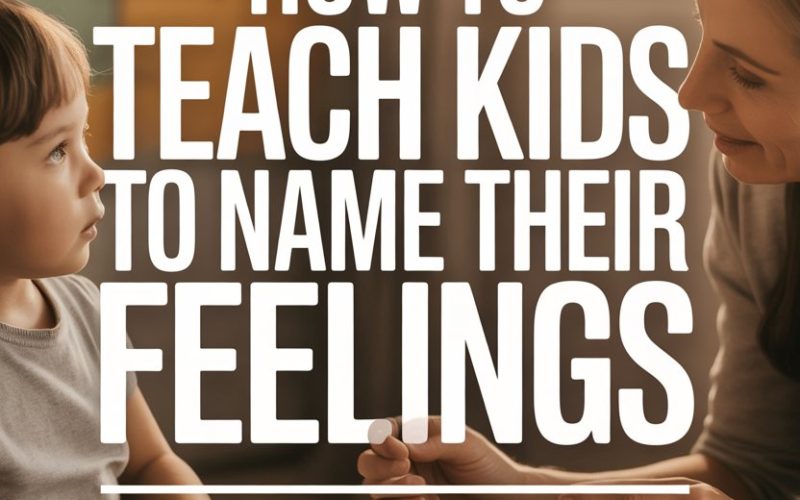Ever tried to guess what’s going through your child’s mind when they’re sprawled on the supermarket floor, wailing with the dramatic flair of a soap opera star? If only they came with subtitles.
Teaching kids to name their feelings isn’t just for the “Instagrammable” moments; it’s a practical superpower that can turn tears, tantrums, and even the occasional sibling wrestling match into golden opportunities for growth.
Here’s how you can help your child learn to put words to the mysterious swirl inside their heads—and maybe, just maybe, save your own sanity in the process.
Why Feelings Need Names
Emotions are slippery things, especially for children.
Adults have had decades to figure out the difference between “annoyed” and “furious” (well, most of us have), but little ones often experience them all as a single, overwhelming storm.
By helping kids label their feelings, you’re handing them an umbrella—and showing them it won’t always rain forever.
Research from the Yale Center for Emotional Intelligence highlights that children who can articulate their emotions tend to manage stress better and show improved social skills.
Put simply: naming feelings is the first step to taming them.
Start With Your Own Feelings
Children are stunningly good at spotting when grown-ups are “not quite themselves.” Modelling is your not-so-secret weapon.
When you label your own feelings out loud—“I’m feeling frustrated because the kettle just broke”—you’re showing your child that emotions aren’t scary or shameful. They’re just part of the human experience.
If you’re worried about oversharing, don’t panic. There’s no need to turn every trip to the loo into an Oprah interview. A sprinkle of honesty goes further than you might expect.
Keep Language Simple and Concrete
Early on, keep it basic. Think: happy, sad, angry, scared, excited. Save “existential dread” for their teenage years (or, you know, Monday mornings).
Speak in words your child actually uses, and resist the urge to break out the thesaurus.
If your child is nonverbal or still learning to talk, visual aids are a game-changer. A simple feelings chart on the fridge, or a set of magnets with faces showing different emotions, can make a world of difference.
Many parents find the Zones of Regulation framework useful for helping children visualise and name what they’re feeling.
Name It in the Moment
Timing is everything. When your child’s bottom lip starts quivering, that’s your cue. In a calm voice, say what you’re seeing: “You look sad because your block tower fell down.”
This isn’t about narrating their every move (“You appear to be experiencing mild indigestion, darling”), but validating what they’re feeling—even if their reason seems minor to adult eyes.
Keep your tone empathetic and skip the “cheer up” pep talks. Just naming the feeling does wonders for helping kids feel understood.
Books Are Emotional Cheat Codes
Picture books aren’t just for bedtime—they’re tiny empathy engines.
Reading stories where characters feel scared, proud, or even jealous gives children a safe window into emotional territory. Pause and ask questions like, “How do you think the bear feels now?” or “What would you call that feeling?”
Top picks include The Colour Monster by Anna Llenas and Glad Monster, Sad Monster by Ed Emberley. For older kids, try Inside Out (yes, the Pixar film, but there are also companion books).
Turns out, you can learn a lot about emotions from a talking ball of fluff or a very animated broccoli.
Make a Feelings Routine
Talking about emotions doesn’t need to be reserved for meltdowns. Sprinkle it into daily life the way you would vegetables—regularly, creatively, and sometimes hiding it in pasta sauce.
Ask, “What was the best part of your day? Was there a tricky part?” during tea, in the car, or while brushing teeth.
Some families keep a feelings journal or a “weather report” chart, where everyone gets a turn to share if they’re sunny, cloudy, or a bit stormy.
If your child resists at first, keep it light. No one likes a forced confession.
Validate, Don’t Fix
Grown-ups are natural problem-solvers. Stubbed toe? Plaster. Sibling squabble? Time-out.
But when it comes to feelings, rushing to “fix” can accidentally make kids feel like their emotions are unwelcome.
Instead, try reflecting: “That sounds really disappointing,” or, “I can see you’re angry because your sister borrowed your favourite jumper without asking.”
By acknowledging the feeling, you’re teaching your child that it’s okay to feel all sorts of things—even ones that make us uncomfortable.
This can reduce the urge to bottle emotions, which, as every parent learns eventually, only leads to more spectacular explosions later on.
Use Play to Practice
Children process emotions through play far better than through lectures. Dolls, stuffed toys, action figures—these are all stand-ins for working through big feelings.
Try creating little scenarios: “Mr. Bear looks grumpy today. What happened?” You’ll be surprised how much your child reveals about their own feelings through a toy’s imaginary woes.
Role-playing tricky situations (“What if someone takes your toy?”) can help too. Play is your undercover agent for emotional intelligence.
Teach the Nuances
Once your child is comfortably naming “happy” and “sad,” sneak in a few more shades. Maybe “disappointed” when plans change, “proud” when they master new skills, or “embarrassed” after a wardrobe mishap.
No need to overwhelm, but as situations arise, offer new words. Children love collecting vocabulary—especially for things that matter to them.
A handy tip: describe how feelings can show up in the body. “Sometimes my tummy feels twisty when I’m nervous.”
Connecting emotions to physical sensations makes it easier for kids to spot them next time.
What About the Big Meltdowns?
When your child is in full meltdown mode, don’t expect a deep emotional conversation. This is not the moment to introduce “disillusionment.”
Keep calm, stay nearby, and ride out the storm. Once everyone’s back to baseline, revisit what happened.
Later, ask, “What do you think you were feeling? What might help next time?” You might not get a clear answer at first—that’s completely normal.
Over time, these gentle post-meltdown chats build emotional muscle.
Model Apologies and Repairs
Everyone loses their cool sometimes—parents included. When you snap or get overwhelmed, own it. Say, “I felt angry because I was worried we’d be late. I shouldn’t have shouted. I’m sorry.”
This shows kids that strong emotions aren’t a character flaw, and that making things right is an important part of relationships.
It’s not about being perfect. It’s about showing your child that feelings come and go, and that what matters is how we handle them.
When to Seek Extra Support
Some children need more help than others—especially those with neurodiverse profiles (like autism or ADHD), speech delays, or trauma backgrounds.
If you notice ongoing struggles with emotional language, frequent violent meltdowns, or behaviour that feels “stuck,” reach out to your child’s GP, paediatrician, or a child therapist.
There’s no medal for toughing it out alone. Early support can make a lasting difference.
Bringing It All Home
Teaching kids to name their feelings won’t guarantee a tantrum-free existence (if anyone cracks that code, please share).
But children who can recognise and express emotions—whether it’s joy, worry, or the deep existential despair of the wrong-coloured sippy cup—are more likely to grow into resilient, empathetic humans.
Bit by bit, you’re giving your child the emotional vocabulary to weather life’s storms—and maybe even enjoy the odd rainbow along the way.
Now, if only there were a word for the feeling you get when you step on a Lego at 3am…





